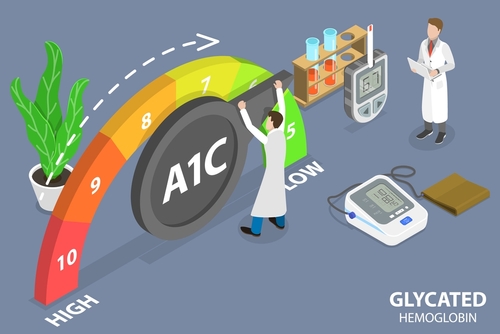Easy Steps to Reversing Prediabetes
According to the American Diabetes Association (ADA), the month of November has been designated for Diabetes Awareness since 1975. But it wasn’t until President Ronald Regan officially recognized it in the early 1980s.
The theme for the World Diabetes Day on November 14, 2022 is “Education to protect tomorrow.” World Diabetes Day provides an opportunity to raise awareness of Diabetes as a global public health concern. It is also meant to enlighten everyone on what needs to be done, collectively and individually, for better prevention, diagnosis, and management of the disease.

Consider that while over 30 million people in the U.S. have some form of Diabetes, one out of four people do not even realize they have the disease. National Diabetes Month is an annual event each November to boost awareness about the risk factors, symptoms, and types of Diabetes. Here at Seattle Sutton’s Healthy Eating, we understand the importance of Diabetes education, especially for Prevention! If you’ve been recently diagnosed with Prediabetes, there is evidence that healthy eating can reverse your Prediabetes!

What is Prediabetes?
A person with Prediabetes has a blood sugar level higher than normal but not high enough to meet the criteria for Diabetes. Usually an A1c of between 5.7% to 6.4%, indicates Prediabetes, and an A1c of 6.5% or more indicates Diabetes.
It is important to know if you have Prediabetes because it may possibly lead to Diabetes. However, a 2019 study from Stockholm, Sweden, found that merely informing a patient that they are “at risk” for developing Type 2 Diabetes or diagnosing a patient as Prediabetic, was not enough motivation for a person to make healthy changes that could reverse their condition. The researchers concluded that more emphasis should be placed on tools and support for reversing the disease which would ultimately serve as a motivator for lifestyle modifications in adults. Giving you tools and support is what I hope to do in this Seattle Sutton’s Healthy Eating Blog!

Know the Risks
An estimated one-tenth of US adults, 37 million people, have Diabetes, and the Center for Disease Control (CDC) expects that to rise to one-third of adults by 2050. A small minority of those have Type 1 Diabetes, an unpreventable autoimmune condition usually diagnosed in childhood. However, at least the other 90 percent have Type 2 Diabetes, in which the body's cells become less responsive to insulin, so that the pancreas can no longer produce enough to regulate blood sugar properly over time. Though the metabolic processes are not fully understood, being overweight and inactive are significant risk factors.
The risks of poorly managed Type 2 diabetes are:
- heart disease
- blindness
- kidney failure
- strokes
- amputations
Type 2 Diabetes is not curable, but it is often preventable. Prevention is key!
A diagnosis of Prediabetes is a warning, says Prakash Deedwania, a cardiologist at the University of California San Francisco. "It's almost saying that you have a deadly disease around the corner and you can do something about it now or suffer the consequences." In an article about emerging strategies for diabetes and cardiovascular disorders Dr. Deedwania wrote, “Thus, it is clear that the future efforts directed towards containing the ongoing epidemic of cardiovascular disease (CVD) will also need to focus on preventive measures aimed at reducing the burden of Diabetes Mellitus in the population. By the time someone develops Type 2 Diabetes, irreversible damage to a person's arteries, kidneys and other organs may have already begun."

Know the Numbers
According to the CDC from data collected from March 2017 to March 2020, obesity prevalence was 39.8% among adults aged 20 to 39 years, 44.3% among adults aged 40 to 59 years, and 41.5% among adults aged 60 and older. They also found, in adults aged 20 and older, the age-adjusted prevalence of diabetes was 14.8%. Considering obesity is directly associated with the prevalence of Type 2 diabetes, the increase in people with diabetes is a potential threat for many people.
Here at Seattle Sutton, we
believe that rather than wait for a Diabetes diagnosis, we should encourage
everyone, not just those with Prediabetes, to consider prevention as a
fundamental aspect. What does prevention mean? Living a healthy lifestyle.

4 Healthy Lifestyle Steps to Help Reverse Your Prediabetes
The CDC started the National Diabetes Prevention Program, a yearlong program designed to help people learn to adopt healthy lifestyle habits. A healthy lifestyle is a combination of these 4 important courses of action and are found to be the key in reversing Prediabetes:

1. Physical Activity
In a Study published in the Journal of physiology, it was concluded that “the major behavior causal factor in the increasing prevalence of diabetes is low levels of activity-related energy expenditure, brought about by technological advances that have largely engineered physical activity out of daily life.” The evidence supported their hypothesis that sedentary habits are a major cause of Diabetes. There was also strong evidence that an active lifestyle reduced mortality risk in people with Diabetes.
Getting 150 minutes of moderate-intensity physical activity each week for adults is the Federal guideline for optimal Diabetes Prevention and has been shown to help reverse Prediabetes. You may split that into 30 minutes, 5 days per week. Just make sure the physical activity you choose is something you enjoy and is sustainable over time. Start slowly, working your way up to more time or more challenging physical activity. One of the best forms of activity is good old walking, something many of us can actually do. There are also other ways and places to be physically active and there are free app options.

2. Lowering stress
According to the American Diabetes Association, Prediabetes and Type 2 Diabetes are not caused by stress, however stress can affect your blood glucose levels. High and low blood glucose levels can affect your emotions, which may cause more stress!
Here are some ways a person with Prediabetes can manage their stress:
- talk to someone
- allow time of prayer or mediation
- spend time with those you love
- find people, books, movies, etc that make you laugh
- allow others to help you whether at work, at home or in every day life
- be physically active as we have already discussed
- find a hobby you enjoy
- focus on deep breathing
- think positive thoughts about yourself!

3. Sleep
Sleep problems and diagnosed sleep disorders are common in our modern society. These sleep disturbances are not always focused on as a factor in Prediabetes. The most common disturbance is insufficient sleep. The culprit seems to be our 24 hour world we live in and social networking. Studies show many of the sleep problems are associated with Prediabetes and Type 2 Diabetes. If sleep is insufficient or does not occur consistently, there is a decrease in both glucose tolerance and insulin sensitivity. This all adds up to developing Type 2 Diabetes. In a study done in 2015, researchers wanted to determine the association of sleep patterns and Prediabetes. It concluded that there is evidence that people with poor sleep quality are more likely to develop Prediabetes than people with good sleep quality. They recommend that people have good sleep hygiene principles. The American Academy of Sleep Medicine (AASM) and the Sleep Research Society (SRS) recommend seven hours of sleep every night for optimum health.
Here are tips for good sleep hygiene:
- Turn off electronic devices 2 hours before you go to sleep.
- Create a consistent relaxing bedtime routine.
- Limit your caffeine intake.
- Control your sleep environment keeping in mind the temperature, mattress, pillows, noise, and lighting.
- Limit napping.
- Manage stress.
- Exercise regularly.

4. Healthy Foods!
A major factor for Prediabetes is a diet high in processed foods, which tend to be high in saturated fats, calories and added sugar, all without nutritional value. Eating a healthy diet can restore normal blood sugar levels. The best piece of advice to help reverse Prediabetes when it comes to food is to start with vegetables and don’t stop until they make up half your plate. There are large amounts of vitamins and minerals in vegetables that help all the functions of the body work better. And most importantly, the fiber in the vegetables help manage the levels of glucose in your blood. Vegetables are key to reversing Prediabetes.
Another important factor to keep in mind are your carbohydrates. Eating fewer of certain carbohydrates can also help reverse prediabetes. Here are tips for eating the right carbohydrates:
- Eat Mostly Complex Carbohydrate
- Unprocessed carbohydrates and include: vegetables, fruits, whole grains, beans
- Rich in fiber which will keep you full longer
- Take longer to break down, so they absorb into your body at a slower rate
- Helps prevent blood sugar spikes.
- Limit Simple Carbohydrates
- Absorb quickly and cause an immediate spike in blood sugar.
- Simple carbohydrates include: sugar, candy, cake, ice cream, soda, honey, juices, sweetened teas.
- Limit Refined Carbohydrates
- Fast-acting also causing spikes in blood sugar. Refined Carbohydrates include white rice, white bread, pizza dough, breakfast cereals, pastries, pasta.

Here at Seattle Sutton’s Healthy Eating we follow the strict nutrition guidelines from the American Diabetes Association, American Heart Association, and Dietary Guidelines for Americans for all of our meal plans. We also follow the basic principles of the DASH diet and Mediterranean diet. This makes our meal plans suitable for someone trying to reverse their Prediabetes. Since we focus on their guidelines for the amount of carbohydrates, added sugar, sodium, protein and fat in our meals, as well as, maintain portion control using individual caloric needs with our 3 Meal Plans, we are able to help our customers reach and maintain a healthy weight and control their blood sugars. By providing people with well balanced, delicious meals, we take the guesswork out of cooking and healthy eating! Good-bye Prediabetes!
If you’ve never been diagnosed with diabetes and haven’t taken a type 2 risk test, now is a great time. About 1 in every 2 people with diabetes don’t even know they have it, according to the International Diabetes Federation.
You can also take a quiz to test your diabetes knowledge.
Check out our Healthy Meal Plans today!

